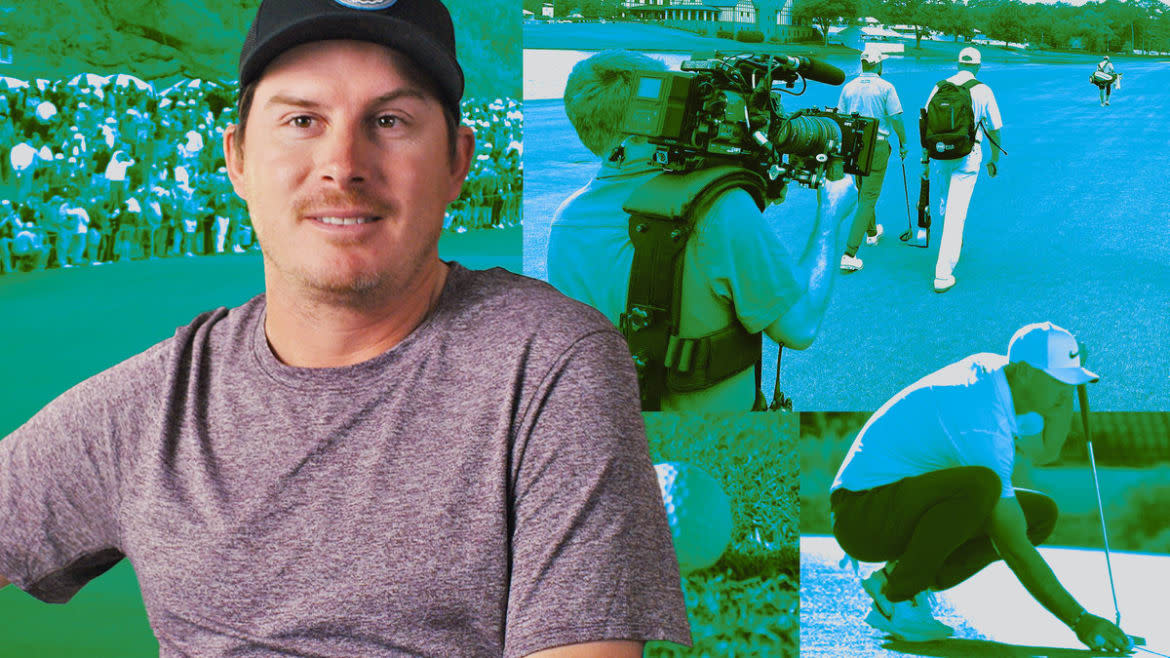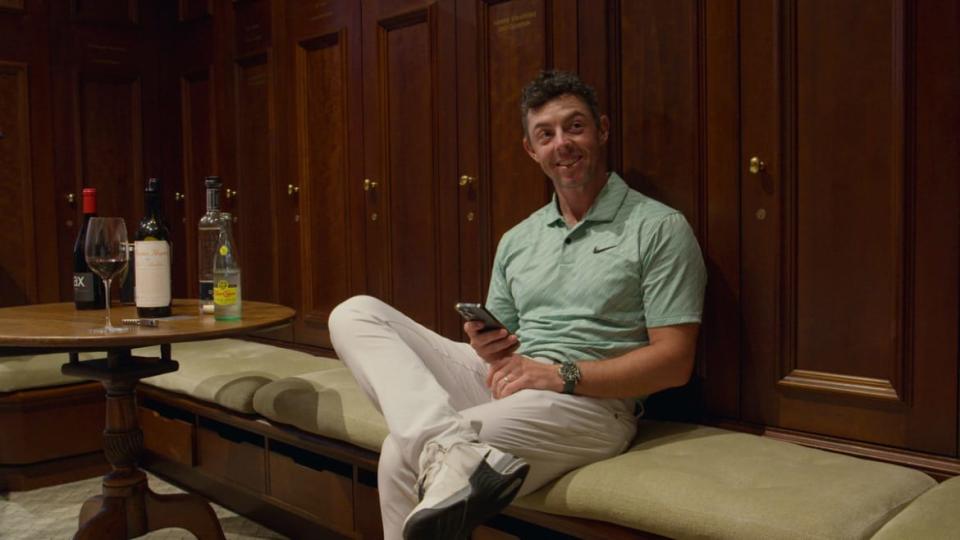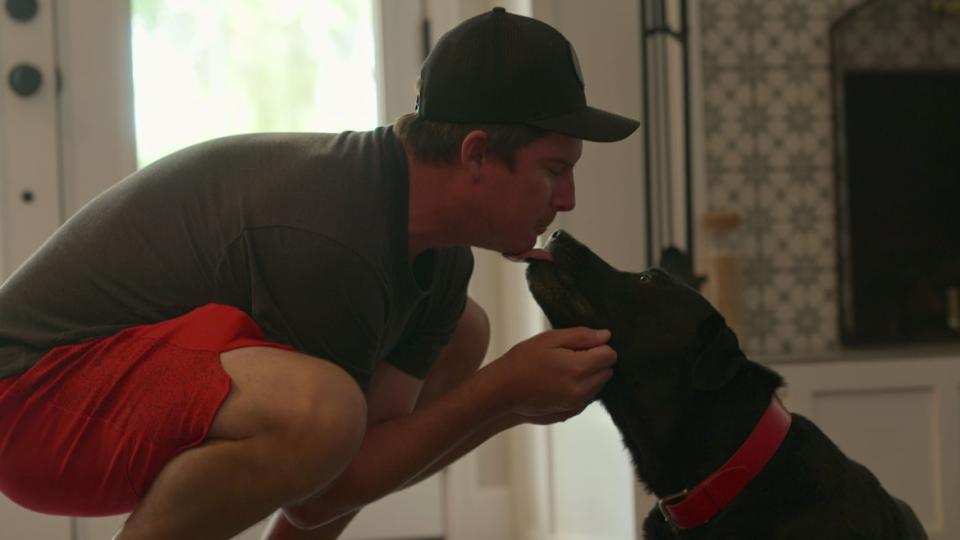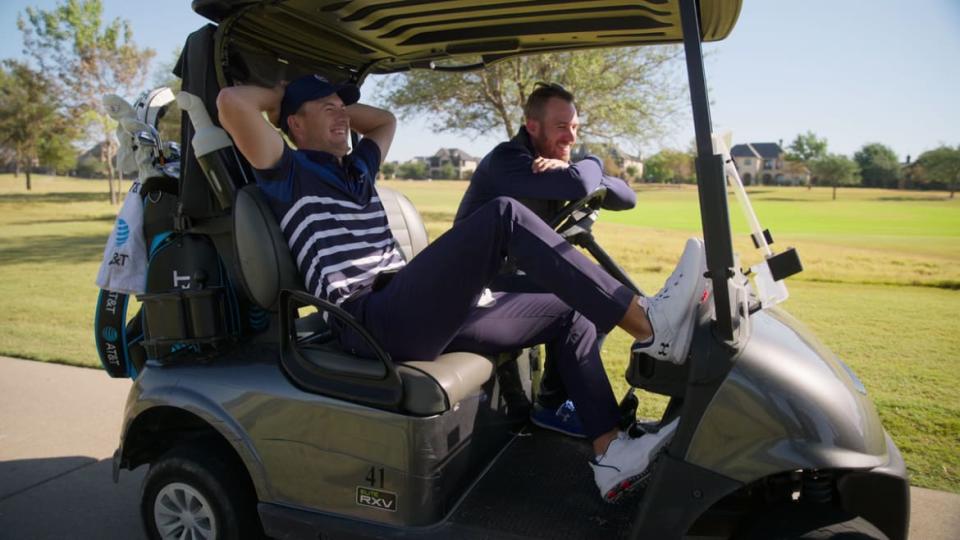How a Reality Show About Golf Won Over ‘Real Housewives’ Fans

- Oops!Something went wrong.Please try again later.
- Oops!Something went wrong.Please try again later.
My dad once offered me two pieces of advice. First, have financial independence, so that I would have the ability to leave a bad relationship at any time. And second? For those work and business conversations that take place outside of the office: learn to play golf.
(Let’s just say I swiped left on golf.)
I’m not, shall we say, a fan of sports. And yet, if television is my love language, I’ve been known to Duolingo for sports-related TV.
Initially, shows about sports like Formula 1 racing felt too far outside my wheelhouse to understand, let alone enjoy. Until I started to watch. The second I turned on Netflix’s blockbuster series Formula 1: Drive to Survive, I was entirely hooked. Here was the flash and sparkle similar to my safe space of Bravo TV and Real Housewives, with equally compelling storytelling.
And yet, when Netflix premiered Full Swing, a show focused on the PGA tour, I clenched. This was it. This was my dividing line. There was absolutely no way I was going to find *golf* interesting, unless it included Tiger Woods’ ex and a Thanksgiving drive. (Not the kind you swing.)
Turns out, sports-based storytelling works even—and arguably especially—with golf. While each individual golfer has some level of support, most especially their caddie, ultimately a golfer is playing a game of strength that can be lost or won through mental resolve. The spotlight is entirely on them. A person’s psyche can be as integral, if not more so, as their swing.
An existential crisis, mid-drive? Sign me up.
Full Swing’s episodes focused on individual professional golfers on the PGA Tour. Some pro golfers, like Tony Finau, Brooks Koepka, and Joel Dahmen, were shown from the outside in, focused more on personal narrative and how outside challenges impacted their game. Others, like Jordan Spieth and Scottie Scheffler, were shown from the inside out, centering on their game play more than their personal lives. The show portrayed players grappling with their legacies, families, frustrations, internal politics, and uncertain futures off the course.
Full Swing is a solid complement to other Netflix sports shows, like its crown jewel Drive to Survive and tennis-themed Break Point—especially for folks who watch because of the story, not because they’re already fans of the sports. And women—like myself—who may be unsure of whether they will feel welcome in an environment outside their usual interests, were exactly who Full Swing had in mind while making the series.
In an interview with The Daily Beast’s Obsessed, Full Swing executive producer Chad Mumm spoke about that cross-gender appeal. But first, I had to ask. Why golf?
BravoCon Wasn’t Just a Chaotic Fan Convention. It Was a Wellness Retreat.
“It’s a really interesting canvas for telling really human stories, because it’s just such a lonely sport,” Mumm said. “It comes down to an individual having to do it on their own. They’re kind of on an island. The way that these athletes process that, you know, who they rely on, what relationships matter most to them, is the whole story.”
As for potential viewers like me, who might be skeptical about golf’s entertainment value, Mumm noted that a suspicious audience was what his team focused on.
“We figured that we had a good chance of getting that [existing] audience out of the gate,” Mumm said. “Just because you’re seeing a world that you’re obsessed with, from (the) inside. But what we really wanted to do was reach a different audience, a broader audience. People who just like great television, not even necessarily a sports audience. The more we got into it, we [were] like, ‘Oh, my God, that’s just like a lifestyle story here.’ You know, it can be a little soapy. And at times, It’s really feel-good. My favorite feedback is, ‘I never expected to cry three times watching a golf show.’”
Mumm acknowledged a perception some of us have about golf: as white, bro, male, and, frankly, dull. “So many people, maybe yourself included, have this notion of what golf is all about in your head. It's a sport that has a stigma. And it's probably a fair stigma. But it’s also changed a lot in the last sort of 10 years.”
Participation in the support has increased across demographics, he said. It’s now skewing younger. There are more people trying it for the first time. It’s more female. It’s more diverse. “There's a big sort of preconceived notion. That just means you can subvert people's expectations pretty quickly, which is a great way to hook people in. And I think this show capitalized on that.”
Turning Golfers Into Reality Stars
Surely asking star athletes—with a lot on the reputational line for their individual brand and sponsorship value—to do reality TV is a big ask. “We worked our way into the trust,” Mumm said, “and some players really embraced it from the beginning. But others we had to be there and build the trust and the trade off.”
Participating in the series certainly produced positive results for some of its star athletes.
Look at pro golfer and breakout star Joel Dahmen’s role on the show, for example. Dahmen’s episode focused on his struggle to appreciate and accept his place as one of the top 100 golfers in the world. Fellow players discussed his lack of confidence, as Dahmen was frequently shown minimizing and making light of his skill—which was the case during a disappointing start to a US Open qualifier. But then, after imbibing on a few White Claws at lunch—Wheaties for millennials—Dahmen came from behind and clinched a spot. He actually led the field at the Open itself, before finally placing 10th. A Cinderella story, straight up.

“I originally said no to it,” Dahmen told The Daily Beast. “I was like, ‘I don't want to be on reality TV, and I don’t want my life blasted all over the place.’ But as I watched a little bit of Drive to Survive, I understood what they were going after. And then you hear about all the other guys who were doing it, and you’re like, ‘Well, the top guys in the world are willing to do this…’”
I asked Dahmen if he has felt any additional pressure competing since the show premiered. “I wouldn’t say [the show added pressure],” he said. “I put enough pressure on myself. And once you’re in between the ropes, it’s just you and the golf ball.”

In fact, Dahmen said the additional attention has helped his game. “I tend to do better when I play in front of more people. I’m more focused, because I don’t want to screw up. It’s easy to kind of get lost out there.”
As for what it felt like to watch himself on reality TV? “You know, it’s one of those things, you don’t like the little mannerisms and you think your voice sounds funny,” Dahmen said. “But overall, on a deeper side of things, I am a proud cancer survivor. I’m a brand ambassador for MD Anderson. I wear a bucket hat with the strikethrough cancer logo. It’s been something that's a part of my life. Unfortunately, you know, cancer has greatly affected my life, but it affects everyone’s life. So I can be a symbol of hope out there for people, and I’m raising money and awareness. So I think that is all good.”
The Latest ‘Vanderpump Rules’ Shows First Signs of Scandoval Affair
While Dahmen had a positive experience on the show, others were put under a harsh lens of critique. But it appears that would have happened regardless of Full Swing’s presence. The golf world was already in a heated debate.
Golf TV’s Uncomfortable Turning Point
‘Disruption’ became the go-to descriptor for professional golfing, after Saudi Arabia launched its LIV Tour. Now golfers were faced with a decision: play for LIV and be permanently expelled from PGA. That carries a seemingly obvious moral quandary: whether to participate in a country’s ‘sportswashing’ of multiple human rights abuses. It’s a crisis for the PGA and the future of the sport, and for players grappling with their own legacy and reputation.
While other professional sports worked to reposition—aka silence—player views around morality as unrelated political discourse, the PGA had another strategy, and incentive. Their interest in having star players like Rory McIlroy speak out against LIV had a positive impact on their bottom line. Full Swing covered the chaos, following LIV players who fought with reporters for asking questions about Saudi Arabia’s human rights abuses. That included golfer Ian Poulter, who joined LIV mid-series, and seemed to laugh off questions that didn’t focus on his choice to cash a (very) large check.
I wished the show pushed back. Both Full Swing and the PGA seemed dependent on McIlroy’s leadership challenging LIV, while working to change the PGA tour to attract and keep fans. McIlroy’s full-throated criticism of LIV seemed to alleviate Full Swing’s responsibility to challenge LIV golfers like Dustin Johnson, Koepka, and Poulter.

Fortunately, there’s always Season 2.
As seen in episodes featuring players Sahith Theegala, Mito Pereiro, and Matt Fitzpatrick, golfers were not as easy to categorize and cast off as I initially felt. And as a woman who is used to seeing other women be openly vulnerable and emotional on reality TV, but not men, this stood out.
As does the moniker of a “guilty pleasure,” often assigned to majority-women shows. The sports universe doesn’t have that consistent critique. And frankly, why would they? Sexism brings with it an implicit appreciation and value for male-focused stories and interests. Women have been vulnerable, outspoken, reactive, and escapist on reality television for years. And yet majority-female audiences have had to seemingly apologize for a passion that sports fans—which include women—haven’t.
And there’s the difference in how emotion is received. Men are seen as brave for sharing feelings of vulnerability and anxiety, because of a culture and society built around toxic masculinity. While women’s emotions are typically both criticized and assumed. Women athletes are often penalized for emotions men otherwise share without consequence. Just ask Serena Williams. And Angel Reese.
Watching and writing about sports reality TV challenged my own ‘rewarding’ of a man’s vulnerability, when that positive appreciation is not equal for women who do the same.
Mumm admitted he hadn’t considered the gender politics at play, including how rare it is for men to be seen opening up. “I think that’s an interesting observation and, you know, my fault for not even really thinking about it that way. But it’s right, you don’t really see vulnerability from men, especially an athlete, masculine men. There’s like that ‘crying after a win’ kind of thing. The actual true vulnerability is not something you really see that often.”
Is ‘Love Is Blind’s’ Most Confusing Couple Actually Getting Married?
Some critics have argued that Full Swing is too flashy, with its private jets and celebrity-multimillionaire-athlete joie de vivre. They say that such displays of wealth might cheapen the brand, during a time in which the future of professional golf is in flux.
While escapism might attract a viewer to a show, it’s the small, private, emotional moments that keep people watching—and that spark conversation around self-doubt, vulnerability, and stress. And yes, gender politics.
All this inspired by a show about golf. I still don’t know, though, whether I’ll take my dad’s advice and get myself some lessons.
Get the Daily Beast's biggest scoops and scandals delivered right to your inbox. Sign up now.
Stay informed and gain unlimited access to the Daily Beast's unmatched reporting. Subscribe now.

